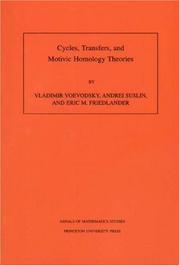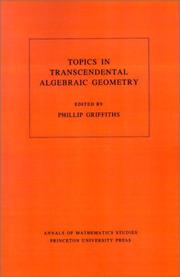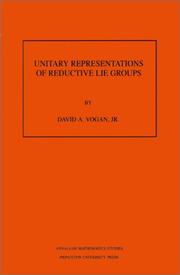| Listing 1 - 6 of 6 |
Sort by
|

ISBN: 0691048142 0691048150 9786613379825 1283379821 140083712X 9780691048147 9780691048154 9781283379823 9781400837120 Year: 2011 Volume: 143 Publisher: Princeton, NJ : Princeton University Press,
Abstract | Keywords | Export | Availability | Bookmark
 Loading...
Loading...Choose an application
- Reference Manager
- EndNote
- RefWorks (Direct export to RefWorks)
The original goal that ultimately led to this volume was the construction of "motivic cohomology theory," whose existence was conjectured by A. Beilinson and S. Lichtenbaum. This is achieved in the book's fourth paper, using results of the other papers whose additional role is to contribute to our understanding of various properties of algebraic cycles. The material presented provides the foundations for the recent proof of the celebrated "Milnor Conjecture" by Vladimir Voevodsky. The theory of sheaves of relative cycles is developed in the first paper of this volume. The theory of presheaves with transfers and more specifically homotopy invariant presheaves with transfers is the main theme of the second paper. The Friedlander-Lawson moving lemma for families of algebraic cycles appears in the third paper in which a bivariant theory called bivariant cycle cohomology is constructed. The fifth and last paper in the volume gives a proof of the fact that bivariant cycle cohomology groups are canonically isomorphic (in appropriate cases) to Bloch's higher Chow groups, thereby providing a link between the authors' theory and Bloch's original approach to motivic (co-)homology.
Bundeltheorie --- Cohomology [Sheaf ] --- Faisceaux [Théorie des ] --- Sheaf cohomology --- Sheaf theory --- Sheaves (Algebraic topology) --- Sheaves [Theory of ] --- Théorie des faisceaux --- Algebraic cycles --- Homology theory --- Algebraic cycles. --- Homology theory. --- Cohomology theory --- Contrahomology theory --- Algebraic topology --- Cycles, Algebraic --- Geometry, Algebraic --- Abelian category. --- Abelian group. --- Addition. --- Additive category. --- Adjoint functors. --- Affine space. --- Affine variety. --- Alexander Grothendieck. --- Algebraic K-theory. --- Algebraic cycle. --- Algebraically closed field. --- Andrei Suslin. --- Associative property. --- Base change. --- Category of abelian groups. --- Chain complex. --- Chow group. --- Closed immersion. --- Codimension. --- Coefficient. --- Cohomology. --- Cokernel. --- Commutative property. --- Commutative ring. --- Compactification (mathematics). --- Comparison theorem. --- Computation. --- Connected component (graph theory). --- Connected space. --- Corollary. --- Diagram (category theory). --- Dimension. --- Discrete valuation ring. --- Disjoint union. --- Divisor. --- Embedding. --- Endomorphism. --- Epimorphism. --- Exact sequence. --- Existential quantification. --- Field of fractions. --- Functor. --- Generic point. --- Geometry. --- Grothendieck topology. --- Homeomorphism. --- Homogeneous coordinates. --- Homology (mathematics). --- Homomorphism. --- Homotopy category. --- Homotopy. --- Injective sheaf. --- Irreducible component. --- K-theory. --- Mathematical induction. --- Mayer–Vietoris sequence. --- Milnor K-theory. --- Monoid. --- Monoidal category. --- Monomorphism. --- Morphism of schemes. --- Morphism. --- Motivic cohomology. --- Natural transformation. --- Nisnevich topology. --- Noetherian. --- Open set. --- Pairing. --- Perfect field. --- Permutation. --- Picard group. --- Presheaf (category theory). --- Projective space. --- Projective variety. --- Proper morphism. --- Quasi-projective variety. --- Residue field. --- Resolution of singularities. --- Scientific notation. --- Sheaf (mathematics). --- Simplicial complex. --- Simplicial set. --- Singular homology. --- Smooth scheme. --- Spectral sequence. --- Subcategory. --- Subgroup. --- Summation. --- Support (mathematics). --- Tensor product. --- Theorem. --- Topology. --- Triangulated category. --- Type theory. --- Universal coefficient theorem. --- Variable (mathematics). --- Vector bundle. --- Vladimir Voevodsky. --- Zariski topology. --- Zariski's main theorem. --- 512.73 --- 512.73 Cohomology theory of algebraic varieties and schemes --- Cohomology theory of algebraic varieties and schemes

ISBN: 0691083355 0691083398 140088165X Year: 1984 Publisher: Princeton (N.J.) Princeton University Press
Abstract | Keywords | Export | Availability | Bookmark
 Loading...
Loading...Choose an application
- Reference Manager
- EndNote
- RefWorks (Direct export to RefWorks)
The description for this book, Topics in Transcendental Algebraic Geometry. (AM-106), Volume 106, will be forthcoming.
Geometry, Algebraic. --- Hodge theory. --- Torelli theorem. --- Géométrie algébrique --- Théorie de Hodge --- Geometry, Algebraic --- Hodge theory --- Torelli theorem --- 512.7 --- Torelli's theorem --- Curves, Algebraic --- Jacobians --- Complex manifolds --- Differentiable manifolds --- Homology theory --- Algebraic geometry --- Geometry --- Algebraic geometry. Commutative rings and algebras --- 512.7 Algebraic geometry. Commutative rings and algebras --- Géométrie algébrique --- Théorie de Hodge --- Abelian integral. --- Algebraic curve. --- Algebraic cycle. --- Algebraic equation. --- Algebraic geometry. --- Algebraic integer. --- Algebraic structure. --- Algebraic surface. --- Arithmetic genus. --- Arithmetic group. --- Asymptotic analysis. --- Automorphism. --- Base change. --- Bilinear form. --- Bilinear map. --- Cohomology. --- Combinatorics. --- Commutative diagram. --- Compactification (mathematics). --- Complete intersection. --- Complex manifold. --- Complex number. --- Computation. --- Deformation theory. --- Degeneracy (mathematics). --- Differentiable manifold. --- Dimension (vector space). --- Divisor (algebraic geometry). --- Divisor. --- Elliptic curve. --- Elliptic surface. --- Equation. --- Exact sequence. --- Fiber bundle. --- Function (mathematics). --- Fundamental class. --- Geometric genus. --- Geometry. --- Hermitian symmetric space. --- Hodge structure. --- Homology (mathematics). --- Homomorphism. --- Homotopy. --- Hypersurface. --- Intersection form (4-manifold). --- Intersection number. --- Irreducibility (mathematics). --- Isomorphism class. --- Jacobian variety. --- K3 surface. --- Kodaira dimension. --- Kronecker's theorem. --- Kummer surface. --- Kähler manifold. --- Lie algebra bundle. --- Lie algebra. --- Linear algebra. --- Linear algebraic group. --- Line–line intersection. --- Mathematical induction. --- Mathematical proof. --- Mathematics. --- Modular arithmetic. --- Module (mathematics). --- Moduli space. --- Monodromy matrix. --- Monodromy theorem. --- Monodromy. --- Nilpotent orbit. --- Normal function. --- Open set. --- Period mapping. --- Permutation group. --- Phillip Griffiths. --- Point at infinity. --- Pole (complex analysis). --- Polynomial. --- Projective space. --- Pullback (category theory). --- Quadric. --- Regular singular point. --- Resolution of singularities. --- Riemann–Roch theorem for surfaces. --- Scientific notation. --- Set (mathematics). --- Special case. --- Spectral sequence. --- Subgroup. --- Submanifold. --- Surface of general type. --- Surjective function. --- Tangent bundle. --- Theorem. --- Topology. --- Transcendental number. --- Vector space. --- Zariski topology. --- Zariski's main theorem.
Book
ISBN: 1400881226 9781400881222 9780691161693 9780691161686 0691161682 9780691161686 0691161690 9780691161693 Year: 2016 Publisher: Princeton, New Jersey ; Oxford, [England] : Princeton University Press,
Abstract | Keywords | Export | Availability | Bookmark
 Loading...
Loading...Choose an application
- Reference Manager
- EndNote
- RefWorks (Direct export to RefWorks)
Over the field of real numbers, analytic geometry has long been in deep interaction with algebraic geometry, bringing the latter subject many of its topological insights. In recent decades, model theory has joined this work through the theory of o-minimality, providing finiteness and uniformity statements and new structural tools. For non-archimedean fields, such as the p-adics, the Berkovich analytification provides a connected topology with many thoroughgoing analogies to the real topology on the set of complex points, and it has become an important tool in algebraic dynamics and many other areas of geometry. This book lays down model-theoretic foundations for non-archimedean geometry. The methods combine o-minimality and stability theory. Definable types play a central role, serving first to define the notion of a point and then properties such as definable compactness. Beyond the foundations, the main theorem constructs a deformation retraction from the full non-archimedean space of an algebraic variety to a rational polytope. This generalizes previous results of V. Berkovich, who used resolution of singularities methods. No previous knowledge of non-archimedean geometry is assumed. Model-theoretic prerequisites are reviewed in the first sections.
Tame algebras. --- Algebras, Tame --- Associative algebras --- Abhyankar property. --- Berkovich space. --- Galois orbit. --- Riemann-Roch. --- Zariski dense open set. --- Zariski open subset. --- Zariski topology. --- algebraic geometry. --- algebraic variety. --- algebraically closed valued field. --- analytic geometry. --- birational invariant. --- canonical extension. --- connectedness. --- continuity criteria. --- continuous definable map. --- continuous map. --- curve fibration. --- definable compactness. --- definable function. --- definable homotopy type. --- definable set. --- definable space. --- definable subset. --- definable topological space. --- definable topology. --- definable type. --- definably compact set. --- deformation retraction. --- finite simplicial complex. --- finite-dimensional vector space. --- forward-branching point. --- fundamental space. --- g-continuity. --- g-continuous. --- g-open set. --- germ. --- good metric. --- homotopy equivalence. --- homotopy. --- imaginary base set. --- ind-definable set. --- ind-definable subset. --- inflation homotopy. --- inflation. --- inverse limit. --- iso-definability. --- iso-definable set. --- iso-definable subset. --- iterated place. --- linear topology. --- main theorem. --- model theory. --- morphism. --- natural functor. --- non-archimedean geometry. --- non-archimedean tame topology. --- o-minimal formulation. --- o-minimality. --- orthogonality. --- path. --- pro-definable bijection. --- pro-definable map. --- pro-definable set. --- pro-definable subset. --- pseudo-Galois covering. --- real numbers. --- relatively compact set. --- residue field extension. --- retraction. --- schematic distance. --- semi-lattice. --- sequence. --- smooth case. --- smoothness. --- stability theory. --- stable completion. --- stable domination. --- stably dominated point. --- stably dominated type. --- stably dominated. --- strong stability. --- substructure. --- topological embedding. --- topological space. --- topological structure. --- topology. --- transcendence degree. --- v-continuity. --- valued field. --- Γ-internal set. --- Γ-internal space. --- Γ-internal subset.
Book
ISBN: 1400885426 Year: 2017 Publisher: Princeton, NJ : Princeton University Press,
Abstract | Keywords | Export | Availability | Bookmark
 Loading...
Loading...Choose an application
- Reference Manager
- EndNote
- RefWorks (Direct export to RefWorks)
Motivated by the theory of turbulence in fluids, the physicist and chemist Lars Onsager conjectured in 1949 that weak solutions to the incompressible Euler equations might fail to conserve energy if their spatial regularity was below 1/3-Hölder. In this book, Philip Isett uses the method of convex integration to achieve the best-known results regarding nonuniqueness of solutions and Onsager's conjecture. Focusing on the intuition behind the method, the ideas introduced now play a pivotal role in the ongoing study of weak solutions to fluid dynamics equations.The construction itself-an intricate algorithm with hidden symmetries-mixes together transport equations, algebra, the method of nonstationary phase, underdetermined partial differential equations (PDEs), and specially designed high-frequency waves built using nonlinear phase functions. The powerful "Main Lemma"-used here to construct nonzero solutions with compact support in time and to prove nonuniqueness of solutions to the initial value problem-has been extended to a broad range of applications that are surveyed in the appendix. Appropriate for students and researchers studying nonlinear PDEs, this book aims to be as robust as possible and pinpoints the main difficulties that presently stand in the way of a full solution to Onsager's conjecture.
Fluid dynamics --- Mathematics. --- Beltrami flows. --- Einstein summation convention. --- Euler equations. --- Euler flow. --- Euler-Reynolds equations. --- Euler-Reynolds system. --- Galilean invariance. --- Galilean transformation. --- HighЈigh Interference term. --- HighЈigh term. --- HighЌow Interaction term. --- Hlder norm. --- Hlder regularity. --- Lars Onsager. --- Main Lemma. --- Main Theorem. --- Mollification term. --- Newton's law. --- Noether's theorem. --- Onsager's conjecture. --- Reynolds stres. --- Reynolds stress. --- Stress equation. --- Stress term. --- Transport equation. --- Transport term. --- Transport-Elliptic equation. --- abstract index notation. --- algebra. --- amplitude. --- coarse scale flow. --- coarse scale velocity. --- coefficient. --- commutator estimate. --- commutator term. --- commutator. --- conservation of momentum. --- continuous solution. --- contravariant tensor. --- convergence. --- convex integration. --- correction term. --- correction. --- covariant tensor. --- dimensional analysis. --- divergence equation. --- divergence free vector field. --- divergence operator. --- energy approximation. --- energy function. --- energy increment. --- energy regularity. --- energy variation. --- energy. --- error term. --- error. --- finite time interval. --- first material derivative. --- fluid dynamics. --- frequencies. --- frequency energy levels. --- h-principle. --- integral. --- lifespan parameter. --- lower indices. --- material derivative. --- mollification. --- mollifier. --- moment vanishing condition. --- momentum. --- multi-index. --- non-negative function. --- nonzero solution. --- optimal regularity. --- oscillatory factor. --- oscillatory term. --- parameters. --- parametrix expansion. --- parametrix. --- phase direction. --- phase function. --- phase gradient. --- pressure correction. --- pressure. --- regularity. --- relative acceleration. --- relative velocity. --- scaling symmetry. --- second material derivative. --- smooth function. --- smooth stress tensor. --- smooth vector field. --- spatial derivative. --- stress. --- tensor. --- theorem. --- time cutoff function. --- time derivative. --- transport derivative. --- transport equations. --- transport estimate. --- transport. --- upper indices. --- vector amplitude. --- velocity correction. --- velocity field. --- velocity. --- weak limit. --- weak solution.

ISBN: 0691082383 1400883989 Year: 1980 Publisher: Princeton, N.J.
Abstract | Keywords | Export | Availability | Bookmark
 Loading...
Loading...Choose an application
- Reference Manager
- EndNote
- RefWorks (Direct export to RefWorks)
One of the most important mathematical achievements of the past several decades has been A. Grothendieck's work on algebraic geometry. In the early 1960s, he and M. Artin introduced étale cohomology in order to extend the methods of sheaf-theoretic cohomology from complex varieties to more general schemes. This work found many applications, not only in algebraic geometry, but also in several different branches of number theory and in the representation theory of finite and p-adic groups. Yet until now, the work has been available only in the original massive and difficult papers. In order to provide an accessible introduction to étale cohomology, J. S. Milne offers this more elementary account covering the essential features of the theory. The author begins with a review of the basic properties of flat and étale morphisms and of the algebraic fundamental group. The next two chapters concern the basic theory of étale sheaves and elementary étale cohomology, and are followed by an application of the cohomology to the study of the Brauer group. After a detailed analysis of the cohomology of curves and surfaces, Professor Milne proves the fundamental theorems in étale cohomology -- those of base change, purity, Poincaré duality, and the Lefschetz trace formula. He then applies these theorems to show the rationality of some very general L-series.Originally published in 1980.The Princeton Legacy Library uses the latest print-on-demand technology to again make available previously out-of-print books from the distinguished backlist of Princeton University Press. These editions preserve the original texts of these important books while presenting them in durable paperback and hardcover editions. The goal of the Princeton Legacy Library is to vastly increase access to the rich scholarly heritage found in the thousands of books published by Princeton University Press since its founding in 1905.
Ordered algebraic structures --- 512.73 --- 512.66 --- Geometry, Algebraic --- Homology theory --- Sheaf theory --- Cohomology, Sheaf --- Sheaf cohomology --- Sheaves, Theory of --- Sheaves (Algebraic topology) --- Algebraic topology --- Cohomology theory --- Contrahomology theory --- Algebraic geometry --- Geometry --- Cohomology theory of algebraic varieties and schemes --- Homological algebra --- Geometry, Algebraic. --- Homology theory. --- Sheaf theory. --- 512.66 Homological algebra --- 512.73 Cohomology theory of algebraic varieties and schemes --- Abelian category. --- Abelian group. --- Adjoint functors. --- Affine variety. --- Alexander Grothendieck. --- Algebraic closure. --- Algebraic cycle. --- Algebraic equation. --- Algebraic space. --- Algebraically closed field. --- Artinian. --- Automorphism. --- Base change. --- Brauer group. --- CW complex. --- Cardinal number. --- Category of sets. --- Central simple algebra. --- Chow's lemma. --- Closed immersion. --- Codimension. --- Cohomology ring. --- Cohomology. --- Cokernel. --- Commutative diagram. --- Complex number. --- Dedekind domain. --- Derived category. --- Diagram (category theory). --- Direct limit. --- Discrete valuation ring. --- Divisor. --- Epimorphism. --- Equivalence class. --- Existential quantification. --- Fibration. --- Field of fractions. --- Fine topology (potential theory). --- Finite field. --- Finite morphism. --- Flat morphism. --- Functor. --- Fundamental class. --- Fundamental group. --- G-module. --- Galois cohomology. --- Galois extension. --- Galois group. --- Generic point. --- Group scheme. --- Gysin sequence. --- Henselian ring. --- Identity element. --- Inclusion map. --- Integral domain. --- Intersection (set theory). --- Inverse limit. --- Invertible sheaf. --- Isomorphism class. --- Lefschetz pencil. --- Local ring. --- Maximal ideal. --- Module (mathematics). --- Morphism of schemes. --- Morphism. --- Noetherian. --- Open set. --- Power series. --- Presheaf (category theory). --- Prime ideal. --- Prime number. --- Principal homogeneous space. --- Profinite group. --- Projection (mathematics). --- Projective variety. --- Quasi-compact morphism. --- Residue field. --- Riemann surface. --- Sheaf (mathematics). --- Sheaf of modules. --- Special case. --- Spectral sequence. --- Stein factorization. --- Subalgebra. --- Subcategory. --- Subgroup. --- Subring. --- Subset. --- Surjective function. --- Tangent space. --- Theorem. --- Topological space. --- Topology. --- Torsion sheaf. --- Torsor (algebraic geometry). --- Vector bundle. --- Weil conjecture. --- Yoneda lemma. --- Zariski topology. --- Zariski's main theorem. --- Geometrie algebrique --- Cohomologie

ISBN: 0691084815 0691084823 1400882389 9780691084824 9780691084817 Year: 1987 Publisher: Princeton (N.J.): Princeton university press,
Abstract | Keywords | Export | Availability | Bookmark
 Loading...
Loading...Choose an application
- Reference Manager
- EndNote
- RefWorks (Direct export to RefWorks)
This book is an expanded version of the Hermann Weyl Lectures given at the Institute for Advanced Study in January 1986. It outlines some of what is now known about irreducible unitary representations of real reductive groups, providing fairly complete definitions and references, and sketches (at least) of most proofs. The first half of the book is devoted to the three more or less understood constructions of such representations: parabolic induction, complementary series, and cohomological parabolic induction. This culminates in the description of all irreducible unitary representation of the general linear groups. For other groups, one expects to need a new construction, giving "unipotent representations." The latter half of the book explains the evidence for that expectation and suggests a partial definition of unipotent representations.
Lie groups --- Representations of Lie groups --- Lie groups. --- Representations of Lie groups. --- 512.81 --- Groups, Lie --- Lie algebras --- Symmetric spaces --- Topological groups --- 512.81 Lie groups --- Abelian group. --- Adjoint representation. --- Annihilator (ring theory). --- Atiyah–Singer index theorem. --- Automorphic form. --- Automorphism. --- Cartan subgroup. --- Circle group. --- Class function (algebra). --- Classification theorem. --- Cohomology. --- Commutator subgroup. --- Complete metric space. --- Complex manifold. --- Conjugacy class. --- Cotangent space. --- Dimension (vector space). --- Discrete series representation. --- Dixmier conjecture. --- Dolbeault cohomology. --- Duality (mathematics). --- Eigenvalues and eigenvectors. --- Exponential map (Lie theory). --- Exponential map (Riemannian geometry). --- Exterior algebra. --- Function space. --- Group homomorphism. --- Harmonic analysis. --- Hecke algebra. --- Hilbert space. --- Hodge theory. --- Holomorphic function. --- Holomorphic vector bundle. --- Homogeneous space. --- Homomorphism. --- Induced representation. --- Infinitesimal character. --- Inner automorphism. --- Invariant subspace. --- Irreducibility (mathematics). --- Irreducible representation. --- Isometry group. --- Isometry. --- K-finite. --- Kazhdan–Lusztig polynomial. --- Langlands decomposition. --- Lie algebra cohomology. --- Lie algebra representation. --- Lie algebra. --- Lie group action. --- Lie group. --- Mathematical induction. --- Maximal compact subgroup. --- Measure (mathematics). --- Minkowski space. --- Nilpotent group. --- Orbit method. --- Orthogonal group. --- Parabolic induction. --- Principal homogeneous space. --- Principal series representation. --- Projective space. --- Pseudo-Riemannian manifold. --- Pullback (category theory). --- Ramanujan–Petersson conjecture. --- Reductive group. --- Regularity theorem. --- Representation of a Lie group. --- Representation theorem. --- Representation theory. --- Riemann sphere. --- Riemannian manifold. --- Schwartz space. --- Semisimple Lie algebra. --- Sheaf (mathematics). --- Sign (mathematics). --- Special case. --- Spectral theory. --- Sub"ient. --- Subgroup. --- Support (mathematics). --- Symplectic geometry. --- Symplectic group. --- Symplectic vector space. --- Tangent space. --- Tautological bundle. --- Theorem. --- Topological group. --- Topological space. --- Trivial representation. --- Unitary group. --- Unitary matrix. --- Unitary representation. --- Universal enveloping algebra. --- Vector bundle. --- Weyl algebra. --- Weyl character formula. --- Weyl group. --- Zariski's main theorem. --- Zonal spherical function. --- Représentations de groupes de Lie --- Groupes de lie --- Representation des groupes de lie
| Listing 1 - 6 of 6 |
Sort by
|

 Search
Search Feedback
Feedback About UniCat
About UniCat  Help
Help News
News